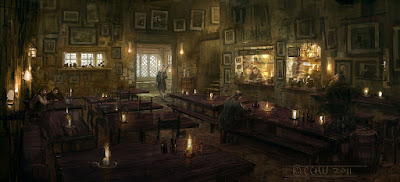Sir Henry Morgan
Henry Morgan, born around 1635 to a Welsh farmer, is
one of the most widely known 17th century pirates. His notoriety
could be partially credited to the widely published literary works of Alexandre
Exquemellin, a barber/ surgeon aboard his ships. However, few pirates would
have made as capturing subject as Henry Morgan. Time and time again Morgan
gives us the thrilling story of a triumphant underdog, evading the more heavily
armed Spanish using his wit, problem solving mind, and level headedness.
Morgan’s career as a privateer in the Caribbean
affected not only the image of pirates in literature but influenced the
historical development of the Americas as a commissioned English captain
working against Spanish reign.
Following in the footsteps of his two uncles, Major
General Sir Thomas Morgan and Colonel Edward Morgan, Henry left school to
become a soldier. According to Coordingly in his text, Under the Black Flag, he joined a military expedition to the New
World “which was dispatched from Britain in 1654 with the aim of capturing
Hispanola” (44). Having bit off a bit more than they could chew, the force
shifted target to Jamaica, a less fortified state, and captured with success.
Although joining the military would have been a great
way to avoid paying for the expensive passage over sea, Morgan would have been
too young. More likely he made his way with the help of his uncle Edward who
served as the Lieutenant Governor of Jamaica before his death.
Under English Captain Christopher Myngs, Morgan’s
military prowess was quickly recognized, and he was placed in leadership. After
several successful raids and the death of privateer leader Edward Mansfield,
Morgan “became the Admiral of the Brethren of the Coast, that loose association
of privateers and pirates which made up the body of men who came to be known as
the buccaneers” (Coordingly, 44).
July 11, 1688 Morgan led his men in the sack of
Portobello, a principle Spanish settlement and treasure port which was under
construction. With nearly 500 men he quickly captured first the lookout posts
followed by the town. The buccaneers corralled civilians into a church and
killed anyone who resisted. Using the mayor and clergy as human shields, they
were able to take Santiago castle as well.
Morgan sent a ransom letter to the President of Panama
demanding 350,000 pesos. After three weeks of negotiations and fighting off
Panamanian reinforcements, the buccaneers received the sum and sailed home to
Jamaica (Coordingly, 46). Because of the scale of this massive success and the
political climate of England the British crown turned a deaf ear to Spain’s
outrage and did not admonish Morgan. His personal rise to wealth and infamy
weakened the Spanish stronghold in the New World.
Once Morgan’s men drank and gambled away their share
of the plunder they were eager to raid again. Their captain took them to Lake
Maracaibo of the coast of Venezuela for easy plunder. However, they encountered
three massive Spanish warships blocking their way home. Morgan used his
trademark wit to deceive his enemy. His men transformed a stolen merchant ship into
an explosive weapon by rigging it with fuses, gunpowder, and tar. They even
used logs to imitate cannons on the sides and crewmen on deck. Leading with the decoy ship, the buccaneers advanced
toward the Spanish warship, set it ablaze, and subsequently captured all three
warships (Stockton, 159).
As a privateer commissioned as an Admiral of England’s
semi-private navy Morgan went on to steal wealth and territory from the Spanish
including the major treasure port of Panama.
While many of us associate privateer Captain Morgan
with rum, his work as Admiral of The Breathren of the Coast weakened Spain’s
hold in the New World. He was integral in England’s colonization of the
Americas and the Caribbean.
Sources:
“Henry Morgan Biography -
Famous Pirate.” Henry Morgan Biography - Famous Pirate, 2020,
www.famous-pirates.com/famous-pirates/henry-morgan/.
Esquemeling, John. The Buccaneers of America. No
Publisher, 2015.
Cordingly, David. Under The Black Flag. Harcourt Brace
& Co., 1995.
Stockton, Frank R. Buccaneers and Pirates. Dover
Publications, 2007.
Minster, Christopher. "Captain Morgan and the
Sack of Panama." ThoughtCo, Feb. 11, 2020,
thoughtco.com/captain-morgan-and-sack-of-panama-2136368.




Comments
Post a Comment